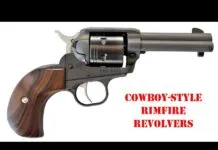These days one hears of the 7.62 x 39, also known as the .30 Russian Short or the Soviet M43, as commonly as one used to hear of the .30-30 a few decades ago. Even in out-of-the-way locales, the short Russian thirty pops up, and plays a major role in survival batteries and in hunting camps. Gun shops regularly stock ammunition for it, often at near-give-away prices. There are several good rifles made in the U.S. today for this cartridge, but the very inexpensive surplus semiauto rifles imported from China in stupendous quantities have started to dry up. A few years ago, they commonly sold for under $100. Today they bring about twice that. When they first appeared, they were new, fairly good guns, and there were so many of them that a significant aftermarket of stocks, scope mounts, high-capacity magazines, and other add-on parts appeared on the gunny scene, and many if not most of those parts are still available, if not everywhere still legal. Occasionally seen were the somewhat higher- quality Russian versions, complete with bayonet.
Along with the SKS types, the AK-47 clones in semiauto version also appeared, carrying names like MAC-90 and PolyTech Legend. There were, and still are in some areas, many rifles available for the Russian short thirty for not a lot of money. The proliferation of the cartridge and guns to shoot it made this generation of U.S. shooters very much aware of the cartridge, its potential and limitations. Many still wonder, however, about the 7.62 x 39. How good are the best pre-ban clones of the AK? Is the SKS, in any of its many variants, a good rifle? Are they reliable? How well do they shoot? And what about modern semiautomatic rifles chambered for this cartridge?
We thought it would be interesting to test some of the finest military-type versions of this cartridge alongside one of today’s modern U.S. offerings, to give the reader some idea of where the cartridge came from and just how good the rifles are.
The Guns
We had access to one of the very best and rarest of the pre-ban AK-47 clones, the Chinese Poly Technologies Legend Series AK-47S, commonly known as the PolyTech Legend, with folding stock. We also tested one of the best SKS rifles ever produced, a genuine Russian version with laminated stock and folding bayonet, arsenal refinished in Russia to new condition. The third rifle was a fine Ruger Mini-30. None of these are particularly easy to find, but do show up now and then. Ruger, for instance, builds a batch of Mini-30s and then reworks that assembly line to produce something else, until another batch is justified. Ruger also chambers its Model 77 for this cartridge.
The Russian SKS is rare today even at large gun stores or big gun shows, but the Chinese version with hardwood stock and no bayonet still shows up occasionally. The Russian version is still legal with its bayonet, though the Chinese SKS can’t have one, because of some ruling pertaining to when they were made or imported. Here’s a tip: You don’t really need a bayonet on anything, so don’t cry if you don’t have one on your rifle.
The 7.62×39 Cartridge
The 7.62 x 39 was developed by the Soviets for the Simonov-designed SKS rifle, which became the Soviet bloc’s standard in 1943. The Russians got the idea from the German 7.92 Kurz (short) used in Hitler’s Sturmgewehr, the first “assault rifle.” Also called the .30 Russian Short, the 7.62 x 39 has a tapered case 1.5 inches long. The pronounced taper is what causes high-capacity magazines to have that curved “banana” shape, and also adds to the reliability of rifles that chamber it, because the cartridge goes into and comes out of the chamber easily. Ballistics are mediocre, the 122-grain bullet generally leaving the muzzle at somewhat under 2,400 fps. Currently, we’re seeing lots of Russian-made non-corrosive but non-reloadable hollowpoint ammunition for sale at low prices. It performed well in our testing, in spite of the fact that the Russian powder produced a foul-smelling smoke.
Many sportsmen use the SKS—usually with sporting stock, and sometimes a scope—for deer hunting, and the cartridge and that rifle are both useful for deer, but that’s about the upper hunting limit. The .30 Russian Short cartridge has more power than a .30 Carbine, but less than a .30-30. Although the SKS or Mini-30 might make good deer rifles, taking the folding-stock PolyTech Legend hunting would seem to be an exercise in misuse of a design. For one thing, the sights of the Legend are simply not the best for precision shooting. We have fired a scope-mounted fully auto version of the AK-47, and in single-shot mode it had questionable accuracy for hunting. The rifle’s design required a high scope mount, was uncomfortable, and we don’t recommend that setup for hunting.
Much of the surplus ammunition available today is not reloadable. However, with soft-nose ammunition so inexpensive and readily available now, there is little reason to reload it. If you insist, many makers offer reloading dies, and you can buy reloadable U.S.-made brass from numerous sources. If you reload, try to match your choice of bullet to your rifle. Overseas-made rifles commonly have a groove diameter of 0.310 to 0.312 inch, rather than our common .30-caliber size of 0.308. However, several bullet makers offer slugs for this cartridge in a variety of sizes. Pick one to match your barrel. Some reloading dies come with two expander balls for different bullet sizes. Although the Ruger bore is made for 0.308 bullets, it will handle the many sizes of surplus ammunition. Slightly oversize bullets don’t give pressure problems at the relatively low intensity to which this cartridge is loaded, but you’ll never get best accuracy or longest barrel life if the bullets don’t match the bore.
We tested three types of ammunition, Russian surplus with a ballistically gorgeous hollowpoint, steel-jacket, copper-clad, boattail, 122-grain, 0.309-inch bullet in non-corrosive-primed steel cases; Winchester FMJ with 123-grain, gilding-metal, 0.310-inch bullet in brass (reloadable) cases; and Czech-made Sellier & Bellot FMJ ball with 122-grain, steel-jacket, copper-clad, 0.311 bullet in non-corrosive steel cases. SAAMI nominal size for the cartridge is 0.310. Here’s how the guns stacked up.
[PDFCAP(1)]
Our recommendation: A fine example of the world’s most prolific firearm, the $1,500 pre-ban PolyTech Legend with 16.25-inch barrel is not a hunting rifle, but a fun gun or study example for the dedicated student of firearms history. It is one extremely reliable rifle, simple, rugged, and well made, and it ought to last many lifetimes. Buy it if you can find it.
Ask any world-class expert on military-origin firearms what is the most prolific firearm in the history of the world, and you’ll find out it’s the AK-47, short for Avtomat Kalashnikov, Model of 1947. The first Russian word means automatic-type rifle, as in selective fire. The second indicates it to be an invention of the talented Mikhail Kalashnikov, who stands with John Garand and Eugene Stoner as one of the premier firearms inventors in history. Although Kalashnikov invented the AK-47, the .30 Russian Short cartridge actually preceded it by four years. The cartridge was originally designed for the 10-shot semiautomatic SKS rifle, an invention of another Russian named Simonov. The SKS became the standard army rifle for Russia in 1943 until it was superseded by the Kalashnikov design in 1947. Our test rifle, the Chinese-made AK-47S, is semiautomatic instead of selective fire, but otherwise is an extremely close copy of the original Kalashnikov.
The PolyTech AK-47S Legend was imported for about one year only, before the importation ban on rifles having pistol grips, high-capacity magazines, bayonets, folding stocks, etc., stopped it. Our test rifle was essentially new in the box, in perfect condition. The package included three 30-round magazines, bayonet with scabbard, original sling, oil bottle, cleaning kit, and detailed instruction booklet. The stock folded forward at the touch of a button, making the rifle darned near a concealed-carry gun.
With its 30-round magazine affixed, and with that business-like folding stock, this rifle defines nasty-looking. One look at it would give Sarah Brady the shivers. However, its great world-wide reputation was gained not from its looks, but from its absolute reliability. They work, come hell or high water, just like our test sample did.
The AK is a gas-operated rotating-bolt rifle, with gas tube located over the barrel. Gas from the fired cartridge is bled off into the gas tube to impact on a pushrod that, in turn, kicks the bolt carrier rearward. The carrier spins the bolt out of lockup and pulls it rearward against a captive recoil spring located at the rear of the receiver. The empty case is pulled from the chrome-lined chamber by a very large extractor, and ejected against a protrusion within the action. The bolt then returns, picking up the next cartridge in the magazine on its way home. There is no way to lock the bolt open except by inserting a cartridge into the ejection port. Also, the bolt closes after the last shot in the magazine is fired. Tactically that might not be what the shooter likes, but because the bolt never remains open, dirt stays out. In bad conditions that always-closed bolt makes some sense.
The safety of the AK-47 design is a long lever protruding forward from a pivot pin located on the right side of the action. The forward arm of the safety covers the bolt-handle port when the safety is on (up). With the safety on, the bolt cannot be cycled, but can be drawn back enough to let the shooter see a round in the chamber. Taking the safety off results in a loud click, which we’ve been told acted as a forewarning to the troops against which this rifle was employed, so they had some advance warning that they were about to be fired on. Experienced forces in Viet Nam taped or wired the safety to avoid that noise. An annoying feature of this safety design is that it drags against the outside of the action, taking the bluing off immediately and leaving a scored line. We taped the receiver under the safety to avoid marring our perfect-condition loaner. Our test version of the design had some very nice features, unlike cheaper clones. For instance, the bolt carrier handle was milled out of the block of steel that made up the carrier.
The trigger of the Legend was a milled, nicely curved, smooth-fronted and comfortable part protected by a stamped trigger guard, and located comfortably forward from the slanted pistol grip. The wood pistol grip had well-done flat-top checkering on both sides. It was held to the rifle by a through-bolt, and was as stout, as well, as a military rifle. The trigger pull had a little creep, then broke at 4.25 pounds. The AK had the best trigger of this test series, and we didn’t think it needed any work.
The forend was a two-piece wood guard that kept fingers off the hot barrel and gas tube. It was comfortable and hand-filling without being bulky. The forend had two slots on each side for heat escape. All the wood was well filled and finished in an oil-type finish. The wood appeared to be a Chinese relative of birch or very plain walnut, a bit soft, light in color, and with no decorative grain.
The sight picture was clean and sharp, consisting of a flat-top post front and a U-notch rear. There was occasional difficulty in getting a fast sight picture because of the sight-guard ears. In a hurry, or in bad light, it was possible to mistake one of the ears for the front sight. The front sight itself was a screw that turned in or out to fine-tune the elevation setting of the rear sight, and drifted sideways for windage. Both operations required a special tool that did not come with the rifle.
The rear sight had markings out to 800 yards (“8”), and a positive-locked elevator that was easily moved in 100-yard increments by pinching between thumb and index finger. Oddly, the rearmost mark on the rear sight was labeled “D”, and gave about the same elevation as the 300-yard mark. The “1” mark, for 100 yards, was the lowest rear sight position. The SKS rifle had a similar setup. The sight radius was 15 inches, not exactly what you’d want for swiftly nailing a deer at 200 yards. The magazine was retained by a spring-loaded lever at the rear of the magazine well. The latch pivot was an extension of the trigger guard. Removing the magazine required a natural-feeling forward press with the thumb while wrapping the hand around the magazine. Locked into place, the magazine was solid, with no rattle. It fed—Surprise!—perfectly, whether it held one or thirty rounds.
Although many millions of AK-47 clones use stamped receivers, this one was milled. Our test Legend had absolutely no frills. The barrel, for example, showed its lathe-turning marks with pride, instead of a polished surface. That gave it a dead-flat appearance. There was a cleaning rod under the barrel.
The stamped sheet-metal folding stock could be deployed or folded with a 30-round magazine in place. The curved shape of the buttplate held it securely against the shoulder. The buttstock pivot had a checkered button on the left side to unlock the stock, and also held the rear sling-attach point. The front sling attachment encircled the barrel at the rear of the gas-bleed housing.
Takedown was extremely simple. Pressing the button located at the rear of the action allowed the guts to come out easily and intuitively. The captive mainspring ensured no small parts would be lost in the field. Reassembly was easy. The drill was to put the parts into place and start the cover into the front end, then press it down smartly over the takedown button.
On the range, the Legend had absolutely no malfunctions Empties were thrown 25 feet off the starboard bow. The target, however, indicated the limitations of a short sight radius and a big barrel. We measured the groove diameter at about 0.315, and that guaranteed two things: 1) the rifle will shoot any ammo without developing high pressure, and 2) the rifle won’t give great accuracy with common ammunition. In fact, some of the Winchester bullets hit tipped. The best group was with Czech-made Sellier & Bellot ammunition (biggest bullet). With it, the Legend put four out of five into two inches. The fifth made it over 4 inches. The worst individual five-shot group was just under a foot, with the Russian ammo.
Lack of accuracy with this rifle wasn’t its whole story, however. The gun performed very well in the role for which it was designed, fast and absolutely reliable hits on large targets at medium range. It was very quick from the high ready position, butt against the shoulder and muzzle pointed downward at 45 degrees. From this position fast hits on targets of opportunity were easy. We tried the Legend with the stock folded, with two hands holding the rifle out in front of us. It was easy to hit a small stump at 25 yards range. Recoil was not a problem with any of the rifles, even when the hands alone took the full kick.
We liked the AK-47S because of its extreme reliability, solid construction and feel, but realize it’s primarily a self-defense rifle for relatively close-range use. It would be ideal in rural areas for home protection, and would also do well for a camp or all-purpose fun-gun, with inexpensive surplus ammunition. We wouldn’t take it hunting unless we could get better accuracy. Today at gun shows and gun shops you’ll see copies of the AK-47 with thumbhole stocks and no bayonets. However, underneath the politically correct stock is the same basic Kalashnikov design. Prices today of the tamer versions run from $350 to $450, depending on condition and maker. The PolyTech Legend is getting rare on the market, but examples pop up from time to time. Our gun was purchased less than two years ago for under $1,000. Today it would sell for around $1,500.
[PDFCAP(2)]
Our recommendation: The $609 Stainless Mini-30 is a fine, reliable and handy rifle that gives good-enough accuracy from its 0.308-inch diameter, 18.5-inch long barrel. The sights and trigger might need work, but the gun is reliable with its proper magazine. Consider a scope.
Our test Ruger was made of matte-finished stainless steel. It had a wood stock, flat black synthetic handguard and shiny black plastic butt plate. The combination of materials of different colors and finishes was not at all attractive. We’d like to see a synthetic stock on the gun instead of wood. However, the woodwork was well done, reminiscent of the 10-22 Ruger stock configuration. The metal was well fitted in a military sort of way. That means the gun was not designed to be a sporter, and made no attempt to look like one.
The Mini-30 is a close copy of the Garand-based M14 action, and has most of its features. The bolt is out in the open, exposed to the elements, and rotates to lock into battery just like the Garand bolt. The bolt is driven open and closed by a spring-loaded activator under the barrel that extends to the right side to become the cocking piece. The motion of the activator is transferred to the bolt through a roller attached to the bolt head. Gas is bled off the bottom of the barrel and transferred to the activator through a system very similar to, but simpler than, that of the Garand. A short stationary piston under the barrel receives the gas and transfers it to the activator. Excess gas is vented inside the forend and escapes through the ports in the handguard. The wood is protected by a steel insert.
We received the test rifle without its normal five-round magazine, so we purchased a 50-rounder made by U.S.A. Magazines for our test. The magazine inserts through the bottom of the action and is held in place by a pin at the front of the magazine well, and by a pivoted arm located two inches in front of the trigger guard/safety assembly. The rifle worked with the proper Ruger magazine.
The rifle was fitted with sling swivels, one at the rear bottom of the buttstock, and one in the bottom of the gas-bleed fitting at the front of the forend. The stock appeared to be of birch, and it had some minor but pleasant figure. Its finish was well done, all pores filled, and the surface was non-glare. The butt plate was black shiny plastic.
The sights consisted of an aperture rear and a tapered, flat-top post front. The rear surface of the front sight was serrated white metal. We blackened it for our testing. The front-sight base was integral with the blade. It encircled the barrel and was held on by a roll pin. The rear sight was a black folding aperture with adjustments for elevation via two small screws, and for windage by drifting after loosening a locking plate held with an Allen screw. The finish of the plate was flat black and gave a good sight picture, particularly so because of the absence of front sight protectors, but our shooters all said they’d have liked the aperture closer to the eye. It was about 5 inches from the eye. The sight radius was 21.5 inches.
The Ruger Mini-30 action has integral scope bases if you care to mount a scope. We did not, but if you want to find the best ammunition for your rifle a scope might help. Nothing says you’ve got to leave it attached.
Takedown was identical to that of the M14. We began by ensuring the gun was unloaded, and then cocked the action. We pried the rear of the trigger guard outward using the hole placed there for that purpose, and the entire trigger mechanism then came out en bloc. That made for easy cleaning and maintenance. Pressing down the barrel lifted the action up at the rear, and we lifted it off the wood in a forward and upward direction. It went together as easily.
The bolt is held open on the Mini-30 by pressing down a button on the top left side of the action. Lock the safety by pressing it rearward, insert a magazine, draw back the cocking handle and let it fly forward, and you’re ready to shoot. We thought the safety on our test rifle came off too easily, requiring a pull of 1.75 pounds. We could see no easy way to make it stiffer. The trigger pull was too heavy. It broke at 5.5 pounds and was very creepy and rough.
We didn’t like the magazine setup particularly. A Millett ten-round magazine was loose and totally unreliable in this Ruger, just like the U.S.A. Magazines brand. The standard five-shot Ruger mag goes in flush, leaving nothing but gravity to pull it out. If it sticks, you have to push from the top. The rifle was reliable only with the proper mag.
Accuracy was quite good, leading us to believe the Mini-30 would respond to tinkering just like the M-14 does. The Ruger has a groove diameter of about 0.308. The smallest test bullets were in the Russian ammo, and we got best results with it. Smallest group was 2.5 inches, and average was 4.8 inches.
[PDFCAP(3)]
Our recommendation: These were all made and/or brought into the country before any ban, and all of them had the bayonet. You can’t have a bayonet on the Chinese version, but hey, so what. We couldn’t find a good use for the bayonet (it’s not even sharp) but to stick into the ground to keep our rifle out of the mud. The rifle was reliable, simple, somewhat affordable, and like the AK-47S, an excellent bit of history. Buy it if you can find it.
The rich, dark color of the laminated stock provided a suitable background for the Russian markings and star on the receiver. The stock was as durable as a wood stock can be. It had two cross bolts to add to its strength. The handguard on top of the gas mechanism was cross-laminated in a contrasting pattern. Although this was not a particularly attractive rifle, it had a look of authority and simplicity that current military-type rifles don’t have.
We were told this rifle was part of a group that were refinished in Russia at Tula Arsenal. The stock appeared to have been coarsely sanded and had a varnish-like coating. The metal was carefully polished and very attractively matte blued, and was stamped with matching numbers on stock, action, bolt, and magazine bottom. The bore was like new, and appeared to be chrome plated. The bayonet blade had matte-finished chrome plating on the blade surface.
The sights were a flat-top front screw/post, adjustable with the same (nonexistent) tool that the AK-47 required. We left it alone. It was protected by a ring of steel that led the eye to the sight and could be used in dark conditions to help point the rifle. The rear sight was a ladder with pinch-type elevator marked to 1000 yards. It had a U-shaped notch that was well sized for the front post, and provided a clear sight picture. The sight radius was 19 inches.
This rifle design has a tactical flaw, and we’ve wondered about this for several years, ever since we fired a Chinese SKS long ago and couldn’t figure out how to recharge the partially empty magazine. There is no way to hold the bolt open unless the magazine is empty. We’ve seen ten-round stripper clips for the SKS, and they are used to recharge the fully empty rifle. The drill might have been to dump the entire remaining rounds (which is very easy to do by pulling rearward on the little lever behind the magazine box), close the magazine, lock the bolt back and recharge the rifle fully from the stripper clip. The loose rounds could then be reloaded into stripper clips as time permitted.
You can buy high-capacity magazines for this rifle type today, assuming they’re legal in your situation. Law enforcement needs might be met this way, if your department is on a budget.
Takedown is quite easy. That little lever at the right rear of the action is turned upward and pulled outward, and then a little forward pressure on the action cover permits it to be removed. All the innards can then be easily withdrawn. A lever on the side of the rear sight permits the gas system to be removed. A chromed piston within the gas tube receives the necessary gas from the fired round to kick open the bolt. The mainspring is, like that of the AK-47, captive, and located behind the bolt carrier.
The safety was a lever on the right rear side of the trigger guard that conformed with the shape of the guard. Turning it so that it entered the space for the trigger prevented the trigger from moving. It also gave a tactical sense to the trigger finger when it was deployed, so the shooter instantly knew when it was on. Taking it off was fraught with the danger of striking the trigger, and caution was necessary. The trigger pull was 5.5 pounds with a clean break.
We found the Russian SKS to be fully reliable, simple, and very strong. It was the most accurate rifle of the test. The smallest five-shot group was 2.6 inches, fired with the Winchester ammunition. The rifle liked the S&B ammunition also, giving average groups of 3.4 inches, with several occurrences of three shots into less than an inch.
Gun Tests Recommends
PolyTech AK-47S Legend, $1,000 to $,1500. It is stout, reliable, well made, and an excellent example of the original AK-47, the most famous military rifle of all time. If you can find one at an affordable price, and can live with the limitations of its type, buy it. It’ll go bang every time. Just don’t take it hunting.
Russian SKS, $400. It is simple, easy to repair, gave good accuracy, and had the strongest if not the most shooter-friendly stock of the trio. We didn’t like the safety. If you can find one and the cost is not prohibitive (around $400 today), buy it before we get to it.
Ruger Mini-30, $609. It was a handy and pleasant rifle with no bad habits. The Mini-30 has a lot going for it, but could stand a trigger job. Its big strength is its relative ease of supply, and you can always get spare parts. If you have trouble finding the other two guns, which is likely, the Ruger is a solid default choice. If we had to pick one of these three rifles for all-around use today we’d probably pick the SKS, but the Ruger would be a close second because of its light weight. We’d pick the AK-47S first by a very large margin for home or car defense, because of its shortness, utter reliability, and tactical features.





























